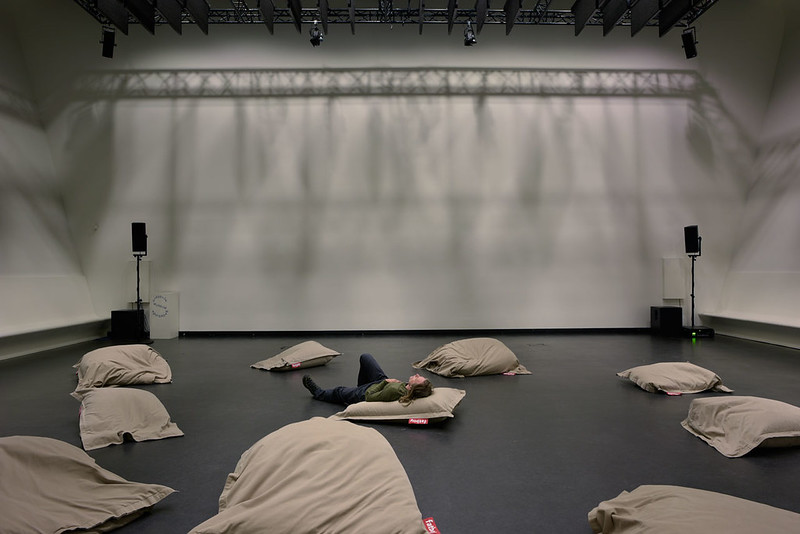In a confluence of realms, Andrew Kesin’s semi-obscure short film Day Trip Maryanne (2004) surveys the collaboration between harsh computer music heavyweight Maryanne Amacher and Sonic Youth guitarist Thurston Moore. The film opens with a wonderful scene in which Amacher blasts Moore with caustic vibrations — tracks entitled “Head Rhythm 1” and “Plaything 2” on Sound Characters (Making the Third Ear) (1999) — in a beautifully lush studio furnished with records, plants, and audio equipment. Moore is rendered in his characteristic schoolboyish haplessness, milling about the room with his fingers jammed in his ears to protect against some of the nastier timbres of Amacher’s aggressive arpeggios and ultramaximal cacophonies. Amacher, looking equal parts wacky aunt and shaman, sways at her station grooving to the swells of punishing sounds, attentive to their subtle phasing. As Amacher pummels with titanic force, Moore’s cautious yet captivated intrigue and hostage alienation facilitate a fleeting recognition: that Amacher is a totemic fixture, an otherworldly cyborg that conjures a sense of sublime, abstract danger, one in which the rational subject — the practiced listener — is violently driven from its perch of codified Enlightenment tendencies into the wilds of raw perception.

Saturday 27 February 2016
De Brakke Grond
Photo by Pieter Kers
Maryanne Amacher is nothing short of a pioneer in conceptual sound art and experimental music. Early on in her career, Amacher studied under Karlheinz Stockhausen, the death-conscious provocateur and mystic who wrote Kontakte (1958-1960), and noted educator of François Bayle and La Monte Young, among others. Stockhausen’s aggressive program of merging composition with cutting-edge technology is distinctly apparent in Amacher’s work. Amacher, in fact, excels in ways that Stockhausen himself never managed, for instance in her harshness and general extremity of incorporated sounds. Amacher’s patented unrelenting style is largely shaped by her unique implementation of otoacoustic emissions (OAEs) in her work. Otoacoustic emissions are, very generally speaking, auditory distortions caused by resonant feedback loops within the hearing apparatus itself, specifically within the cochlea. The manifested effect is a shrill — although not necessarily high in frequency — enfolding contortion of the heard environment. It is like a sound crossing over the threshold between loud and damaging, appearing to inundate the hearing organ — so much so that the ear hits its limit and the quality of its function shifts. Evan Parker’s Monoceros (1978) and Amacher-adherent Florian Hecker’s Triadex Muse Treks (2012) illustrate this phenomenon in a discernible, lean fashion, allowing for the sonic affect of these emissions to be readily observed. Evoked otoacoustic emissions (external signal + internal organic feedback) widely differ from more general sonic phenomena (external signal) in how they are perceived; in the case of the former, the spatiality of sound as material is rendered increasingly opaque, as its timbral shifts occur by means of internal resonance, responding to external quality, yet distinct from it.
Amacher’s work lies here, in between (a) the auditory presentation (the external, a physical alterity) and (b) the assertion of the contours of the body’s hearing faculties (the internal); this establishes a perceptual dissociation within the subject (the subject as-becoming-alien — a psychic alterity — by means of the jarring rupture of the aesthetic event). Amacher states:
When played at the right sound level, which is quite high and exciting, the tones in this music will cause your ears to act as neurophonic instruments that emit sounds that will seem to be issuing directly from your head…[My audiences] discover they are producing a tonal dimension of the music which interacts melodically, rhythmically, and spatially with the tones in the room. Tones ‘dance’ in the immediate space of their body, around them like a sonic wrap, cascade inside ears, and out to space in front of their eyes … Do not be alarmed! Your ears are not behaving strange or being damaged!…[T]hese virtual tones are a natural and very real physical aspect of auditory perception, similar to the fusing of two images resulting in a third three dimensional image in binocular perception…I want to release this music which is produced by the listener… [1]
It is through this tension between the environmental acoustic territory and the limits of the senses that the aesthetic value of the work creeps in, incarnated as hallucinations, deliriums, detachments, delusions, mirages, phantasms, and specters. Amacher’s dedicated work with otoacoustics is arguably her greatest aesthetic contribution, as it emphasizes a method of material mutation — that is, formal innovation — deeply rooted within the physical attributes of the medium. (This is similar to the functions of ultrasonic and sonic weapons.) It is a creative practice that is highly attentive to its infrastructural foundation, yet readily communes with the listener beyond it in an enriched, transcendent dimension. In these otoacoustically-driven compositions, these pieces that heavily rely on aural hallucinations, the listener is met with raw auditory input that is majorly shaped by cognitive nuance; the ear and brain become the problematic nexus of the aesthetic experience, an experience that is not fully represented in the physical acoustic properties of the composition independent of the listener. Therefore, it is the total aesthetic experience that mutilates relationships among listener, body, rationality, and performance: an acoustically-catalyzed psychogenic dissociation.
But even in her non-otoacoustic work, Amacher still conceptually incorporates themes of dissociation. For instance, in her City-Links project (1967-1981) — in which streams of ambient field audio are remotely mixed together into a single piece — the listener is presented with a perceptual environment that is disjointed and anachronistic to itself. The program notes for the 17th International Symposium on Electronic Art in Istanbul describe the project as “[showing] how site-specific sound can be transported to a different location… This work engages with the idea of aural geography being used to portray ‘absent locations’ — where the site of the sound is removed from the audience’s location,” a tactic of softly impressing a fragmented vestige of an experience to create blurry chimeras. Amacher embeds the body into the process of sonic transmission in her artwork, disrupting the linear relationship between object and subject. The listener is located in one place while the sounds emanate from another, creating wormholes through and along which the listener traverses. In Amacher’s work, subject becomes the node of synthesis between objective stimulus and internal faculty. What emerges this time is a conceptual methodology of dissociation based in acoustics and space, a poetics of spectrality and alienation in which the aesthetic experience defies rational sense through the visceral. This conceptualism neatly pairs with the accomplishments of her more psychological and biological otoacoustic works.

Now, somewhat distinct from Amacher, pianist and composer Julius Eastman, a colleague of Morton Feldman’s, refined an instrumental sensibility minimalist in essence yet decidedly less austere and considerably more elusive; Eastman politically radicalized traditional instrumental tendencies with an occult suppression of the Human, forcing a collapse in perceptual causality. Both artists worked beyond standard notions of musicality, favoring instead potently-embodied sound that interacts with the listener in disorienting and fluid ways. Eastman’s Evil Nigger (1979) traditionally features four pianos elaborating on a very elegant and simple score. Generally, the pianos are performed on with their lids totally removed, ensuring that the various piano voices are indistinct from each other: a delirious, psychotomimetic performance in which the linkage between source and listener is blurred dramatically. The voices become strikingly diffuse and convoluted, ultimately sounding like one extremely complex, at times overwhelming, unified voice, phasing in and out of discernible musicality rather than several individuated parts playing in concert. The piece does not even stipulate that it must be performed by four pianos, adding another metastructural, nomadic layer to its articulation and increasing the piece’s general lack of specificity. This feature of the work is crucial, as it causes the piece to be experienced in a certain way, determined by its amorphousness. Evil Nigger creates a musical and atmospheric gist, not an explicitness, in which the sound as it is heard is divorced from the specific generative objects, the musicians and their instruments. What arises is a sound of indistinct poetic potential: shifting, non-linear works that are born out of confluence, interference, and difference. The work, as true art tends to, betrays its own rational descriptions.
The outwardly-stable (and falsely pure) musical architecture of piano music, of chamber music, collapses as it is conflated with itself, as melodies collide and coalesce in ebbs and flows. Eastman, whose ruminating compositions are reminiscent of Steve Reich, yet devoid of the baroque romance of more popular minimalists such as Philip Glass, manages to carve out — or more appropriately, pile on — a music of wraithy summation. It is in this sense that Amacher and Eastman are united in a shared artistic practice; they both investigate the literally unsettling music that is buried within, between, and beyond tones, and in doing so create a new music of dissociation. In comparison to Amacher, Eastman maintained more explicit political engagements in his work, as is obvious in the titles of his pieces: Evil Nigger, Crazy Nigger (1980), Gay Guerrilla (1980), Buddha (1983), and If You’re So Smart, Why Aren’t You Rich? (1977). However, his method of politics is enmeshed in his aesthetic project of spectral aesthetics, which jars the listener from a historically-homogeneous method of musical relation.

Looking at the work of Amacher and Eastman together is useful as it illustrates a class of sonic practice that fractures the orthodox fixity of how an aural environment is typically digested. Most of this affect is received on a subconscious or intuitive level, but the tacit coloring of such phenomena underlies the entirety of the aesthetic experience. Now, many artists work with aural hallucinations such as otoacoustic emissions and acoustic blending to get the exact sounds they want to be present in their work; while Amacher and Eastman have no special claim to this particular strain of aesthetics, their particular cases demonstrate how sound can be used to deeply disturb rational notions of identity. These two artists simply happen to present highly potent, formally-rigorous examples of such trends. Sound is so often characterized as abstract, yet it can be located as a contentless, affect-driven form that doesn’t have to rely on sentiment as its means to establishing significance. Amacher and Eastman both are invested in the medium and its constraints; however, they are not invested in the commonly associated aesthetic applications, which align the two artists with the rule breakers, the window smashers, and the soothsayers, more so than the pianists, programmers, and recitalists. These dissociations allow for the birth of ghosts into the world: ghosts that haunt and hallow, unearthing dimensions in which nothing is the same and everything is alien.
More from this issue